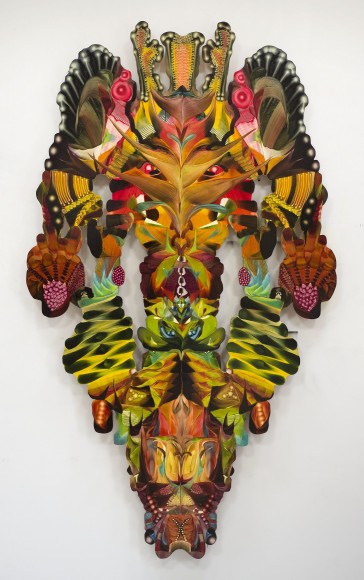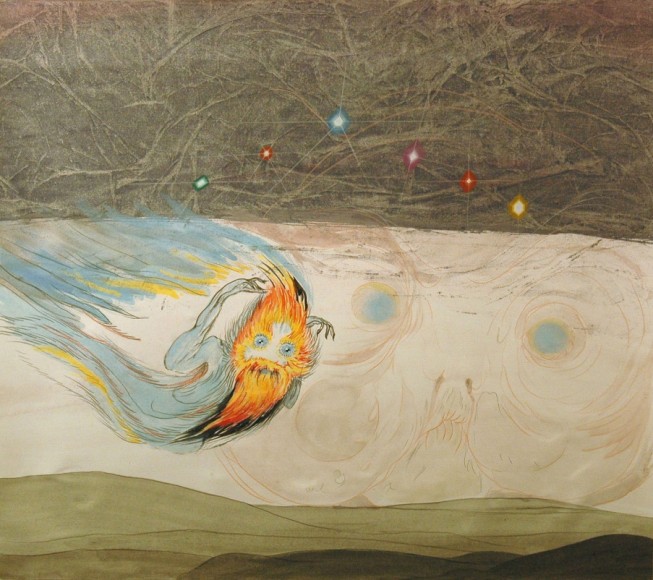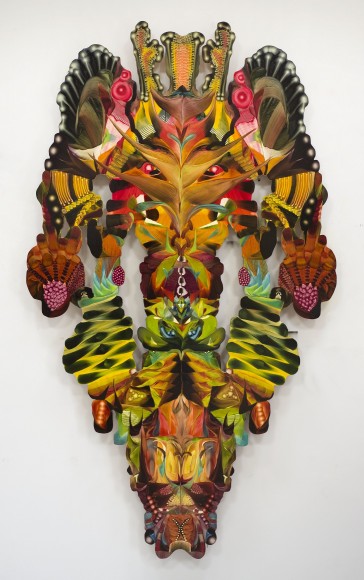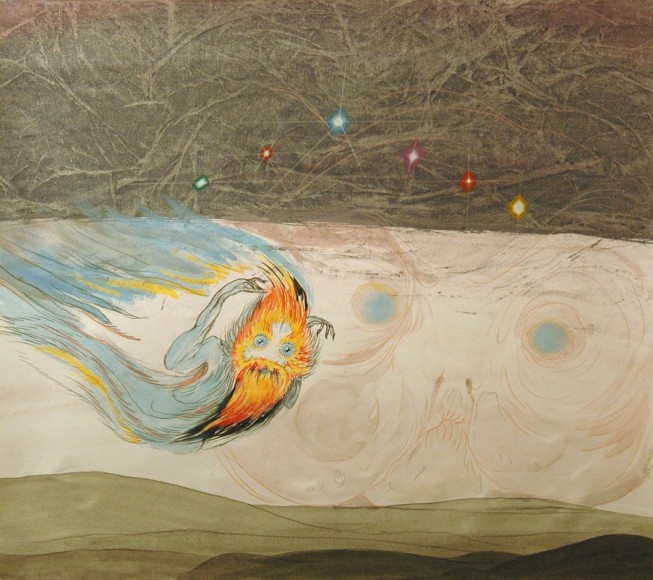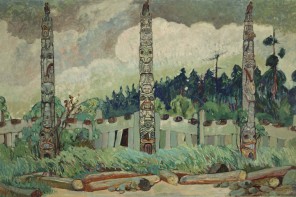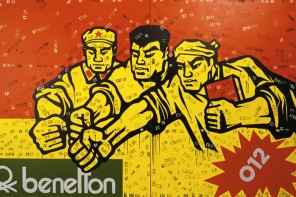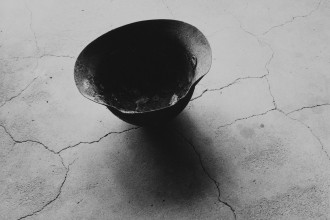The fourth floor of the Pump House Gallery looks down upon the third: a grey, rectangular atrium flickering with screen-light from the black and white film shown below. Stretched across the space between the floors, is a flattened monochrome mask; an unfurling mass of pattern split by a vertical symmetry, coal eyes burning within a Rorschach ink blot of living matter swirled in oil paint. Pigs, people, jungle, villages, a skull: scenes cut out by the curved wooden edges of Andy Harper’s The Three Fold Law, 2012. Gazing across its slick surface, a goatish icon approaches from the centre of the associative abstraction, expanding from some unknown centripetal force.
Travel down to the third floor to sit before the looped screening of Ben River’s Creation As We Saw It, 2012 and look up: you’ll see the colourful, elephant-faced undercarriage of The Three Fold Law. Drained a little of its bright variety by the silvery ambience in the room, it nevertheless retains the characteristically kaleidoscopic quality of Harper’s painting: tunnel-visions through mutating organic forms, some natural, some imaginary. Smaller works by Harper can be peered at—sadly from quite a distance—in the adjacent stair well. Abloom and fading, the disorientating detail of the vivid, butterfly-print images of buds, branches, creeping stems and vegetable rot seem to keep metamorphosing into Giuseppe Arcimboldo’s portraits, tribal masks and hollowing animal craniums. Creation as we see it.
River’s film tells us sweet, sad creation stories over scenes of modern day life: a modern day that is a combined world of the old and the new, ancient and modern. Using purposefully archaic technology, Rivers’ hand-developed, 16mm film silently narrates the myth of a volcano’s birth on the island of Tanna of the Republic of Vanuatu, the bringing of fire and the beginnings of human life in one of the worlds oldest known settlements. A lasting interest in the forgotten secrets, the mothers of myth in pre-history appears to be the curational topic at hand, yet it is a messy, indiscriminate wealth of time that flows throughout the exhibition, overlaying the contemporary with the historical. A time before time becomes a forever present; something we reach behind the scenes for, underneath, digging fingernails into the basal mess. Time is just another ambiguous construct alongside the real and the imaginary, consciousness facing the ambivalence of the natural world.
The amorality of nature—the disinterested, essential and unifying force at work in many of the included artists work—underpins River’s interest in alternative ways of living that are neither utopia not dystopia; totally ordinary yet remarkable places. Often filming exceptional individuals or singular communities, Rivers is drawn to places that are distinctively authored and shaped by the people he films, documenting the reality and the possibilities of our fictions. Camera led, eyes rest on close up portraits of the island’s contemporary inhabitants—a boy rides a bike in circles; bare shoulder blades open and close as man claps—he swings his arms, unheard and walks along a tree-shaded path; another, older man, masticates in the doorway of his house, trying not to laugh self-consciously under his hat. Inter-cut by the fable of pig and man, their exchange of limbs, short and long, a woman rubs the belly of a blissful, dusty hog. In another shot, the curious curl of a human toe nested above the other detracts attention from the animal skull that hangs above the foot. Picking out detail within disarray; depicting creation as we see it.
Primordial or post-apocalyptic landscapes or both, strange fictions, organic and geological, continue to evolve throughout the exhibition: places bound by natural forms yet authored, manipulated and mythologised. Journeying further down towards the centre of the earth, the second floor displays sculptural specimens from the veins of volcanoes, the fungal growths and sedimentary build-up of wet caverns, and the pulsating ocean floor. Salvatore Arancio’s ceramics gasp hot, guttural names like Ah-ah, 2015 or the electronic rhythm of Ziwzih Ziwzih Oo-oo-oo, 2012; are called after tiny ancient crustaceans, living fossils such as Triop, 2005; or simply state their form as in Holes, 2015—sea-bottom calcite tubers popping open to extend modelling compound limbs. A graphic photo-etching on the wall states its subject: An active volcano summit in the valley of stones, 2011. While Arancio’s work dominates the room, the odd pairing with Caroline Achaintre textile work is less peculiar than it first appears. I can imagine them both pouring through books for curious images, editing and combining and elaborating their sources to create hybrid objects. The man-made fuses with the natural in Arancio’s sculptures, reinterprets found images using a combinations of new and ‘outdated’ techniques in his etchings, while geometric ink blots on printed paper transform natural geologies into something synthetic and strange. Achaintre’s woolen zebra pelt, Zibra, 2011, is a similarly re-sourced modern exoticism: the animal pattern crafted into an angular geometry of hand-tufted wool, zigzags of blue and gold invading the black and white regulation in a dramatic, and slightly absurd, combined order. Creation as we make it.
Down, down on the ground floor, or the first floor, at the beginning and the end ,is another seemingly odd coupling between Jack Strange and Vidya Gastaldon. As much as Strange is sincere in his humour, poking fun at and through visual manipulations—how we visualise ourselves and our relation to the world around us through things, including art—Gastaldon has humour in her sincerity. Her allegorical drawings, inspired by sacred Hindu texts, are littered with pop references and drug culture, not least the acid smiley—a contemporary payote for the modern day mystic. Said by the artist to represent a non-duality or cosmic unity of good and evil, Gastaldon’s pale drawings hatch within papery voids like planets being born, cells growing in a Petri dish or terrine-like bubble worlds, evolving microcosms living and dying in the vastness of the universe. The elephant within Ulephant, 2006, is revealed in particulates of rock formations and tree-trunks, serially blossoming within the landscape: mountains and planet strewn skies divided by a horizon line that delves into a subterranean world. In Fire and Emptiness Flight, 2008, both ghostly spirits seem essential to the other, creating space underneath a densely buried but bejewelled cosmos. Such apocryphal binds of creation and destruction trail thematically throughout the The First Humans and yet, as in Gastaldon’s work, these binaries are subsumed by an overpowering ambivalence between them, like the entangled symmetry of Harper’s painting or the tragic birth of a volcano that forms the world: the dualism of beauty and decadence, life and death, utopia and dystopia, the sardonic or knowingly cliché, and a true, mystical sincerity. Ambiguity trickles down the inside of this re-purposed, post-industrial pillar like good-natured laughter.
There are a just lot of eyes in this first/last room, looking, grinning, laughing. From the spirits sketched in pencil and graphite in Gastaldon’s watercolour bled drawings to Strange’s series of paired tumble stones, each inserted into rectangular cardboard sheets, a deadpan host of level gazes from the back wall. Entitled, What do you want more of? (I)–(XXIII), 2010, each stone is supposedly imbued with different desirable characteristics. They remind me of birth stone earrings piercing cardboard backing in a craft shop: material, objects, on which to project ourselves and our meaning on, or take some meaning from and award it to ourselves. How easily manipulated have I been by the work in this psychedelic exhibition? Seeing faces, gods, archetypal myths, an exotic state of nature (neither Edens, utopias nor disinterested dystopias), and exotic, carnival incarnations: documented fictions of the pre-historical and primitive. The confounding cliché of creation as we see it, as we see ourselves in relation to the world: aliens, apes, cavemen—the bizarre characters that Strange rattles around dressed up as inside Lump Inside a Lump, 2012, a video set into a clumsy papier-mâché boulder.
On entering the Pump House, the wall text directs your thoughts downwards before you journey up through the four rooms of the exhibition, asking you to think about the grounds of London, the fertile muck of time and the swampy land that once was—that which fuelled the defunct power station nearby, a site currently undergoing phase of moneyed, metropolitan development and property speculation —from the equally repurposed art gallery in a city park. There is a hint of JG Ballard’s alternative Londons; psychedelic journeys through the looking glass of modern urbanity where civilisation becomes entwined with the primordial and we catch sight of ourselves growing, dripping with it, acting within a transformational landscape. Authored landscapes in metamorphosis. Creation as we see it, as we over-write it, as we see ourselves, at the beginning and the end: the first humans.
The First Humans is at Pump House Gallery from the 22 January until 27 March 2015.

